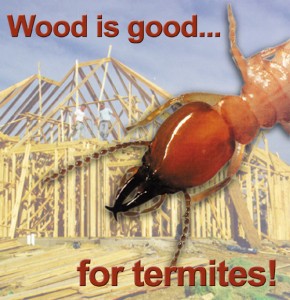Avoid Costly Chemical Treatments with Steel Buildings
Pre-engineered metal buildings do not need to be treated with outgassing chemicals to ward off termites. No termites— even those voracious Formosan termites— can make a meal of steel.
 Think termites are a small problem? Think again.
Think termites are a small problem? Think again.
Termites: Little Enemies, Big Appetites
In order to discourage termites and other insects, dangerous chemicals must be used to treat the lumber, the building, and the soil surrounding the structure.
These deadly chemicals evaporate, affecting indoor air quality. Moreover, these expensive treatments need to be repeated every few years to remain effective.
The sheer numbers on termites is frightening:
- Termites cause more building damage annually than fire, floods, and tornadoes combined.
- There are 45 different species of termites in the U.S.— including the relentless Formosan termites.
- Over 600,000 structures in the U.S. are damaged annually by termites.
- Americans spend over $5 billion each year for termite control and damages inflicted by termites.
- About 3.6 million structures receive termite treatment each year.
- Termites build nests in walls that remain undetected for years.
- Subterranean termite colonies number from 60,000 to over 1 million.
- Formosan termite colonies number from 2 million to 10 million. Their underground tunnels may extend 10’ deep into the soil and cover a half an acre.
- Termite queens in some species can live 20-25 years, laying 2,000 eggs per day.
- Termites eat 24 hours a day without resting.
- A mature colony consumes about one pound of wood per day.
- Formosan termites do the most damage in the least time. They can extensively damage a wood structure in less than six months.
- On average, 10% of buildings not treated will experience termite damage.
- Undetected, termite structural damages may include sagging roofs, stressed or broken main beams, and sloping floors in wood-framed structures.
Termiticides: Chemical Concoctions to Kill
Termite treatments are meant to kill. That is their purpose. Who wants to be breathing toxic chemicals as they pollute the air?
And what about the water pollution? Soil treatments around the structure discourage termite invasions for a while. But inevitably, these dangerous chemicals will spread into the water system.
Lumber Treated with Chemicals
Chemically treated lumber is another way the construction industry tries to thwart termites.
Pressure-treated lumber discourages termites works, after a fashion. Still, treated lumber remains vulnerable to persistent termites.
Formosan termites find ways around the chemical barriers.
The “seal” of treated wood is broken every time the lumber is sawed. Formosan termites not only enter through the cut ends of the lumber, they create passageways over the lumber surfaces to get to the next cut in the framing.
Moreover, the sawdust created by every cut disperses the chemicals into the surrounding air to be inhaled by every living creature in the area.
Experts advise those working with treated lumber to wear safety gloves and a respirator with mask and goggles. Sawdust must be thoroughly cleaned up. They also strongly recommend taking a long shower after working with treated lumber, and washing clothing separately to avoid cross contamination.
Arsenic resides near the top of the Environmental Protection Agency’s (EPA) list of hazardous substances. It was banned from production in the U.S. in 1986. Yet the lumber industry continued to import arsenic from third world countries to be used in chromate copper arsenate (CCA) pressure-treated lumber. CCA was finally outlawed— for most uses— in 2003. Other, supposedly “safe” chemicals being used now for pressure treating lumber cost 10%-20% more.
Getting rid of excess treated lumber presents more problems.
Pressure treated wood is unsafe to burn. Many landfills refuse treated lumber. Normally, only lined landfills accept treated lumber— and then only for a fee.
Breathe Easier with Termite-resistant RHINO Metal Buildings
What is the alternative to using chemically treated lumber and periodic expensive termite treatments?
Build with steel.
Steel buildings are inorganic. They provide no cellulose for termites to munch on. Metal buildings do not require wood sheathing either, eliminating another food source for termites.
Organic wood framing moves as it ages, splitting, creeping, rotting, and settling as it creates small gaps for termites to enter. Termites can enter a gap as small as 1/32 of an inch.
RHINO steel buildings go up perfectly straight and tight and stay that way over the years. There are no telltale breaks inviting termite or vermin to enter.
Steel is strong, durable, non-toxic, recyclable, and termite resistant building material.
Why not call RHINO now at 940.383.9566 for quote on your next commercial, industrial, or residential building project.
Related blogs:
- Build Easier with Metal Buildings- Part 1
- Breathe Easier with Metal Buildings- Part 2 (Mold)
- Breathe Easier with Metal Buildings- Part 4 (Noise)
- Breathe Easier with Metal Buildings- Part 5 (Trees)
